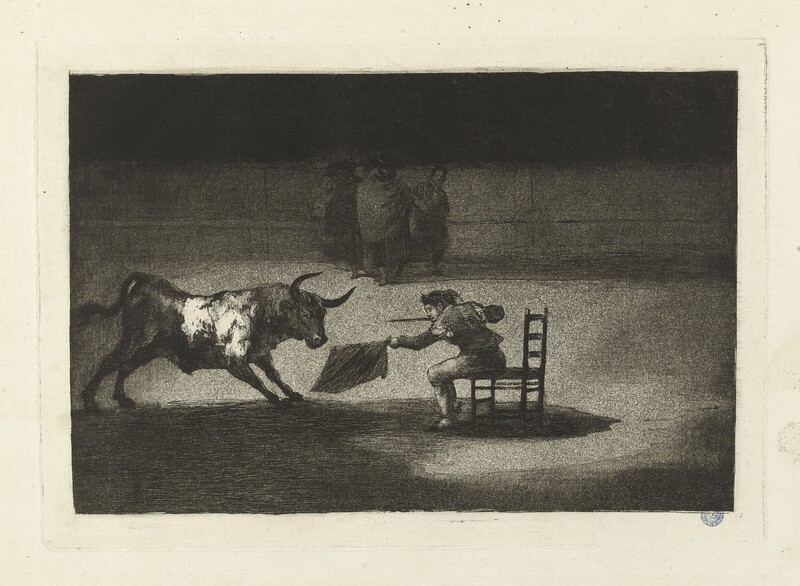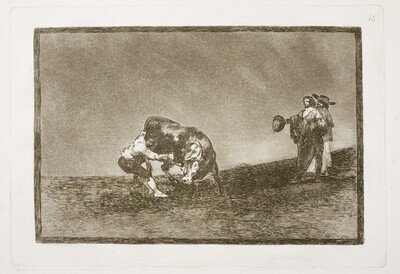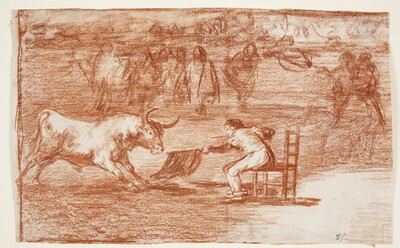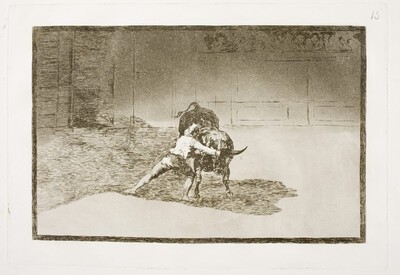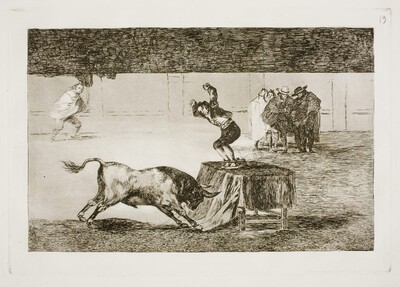- Cronología
- 1814 - 1816
- Dimensiones
- 245 x 350 mm
- Técnica y soporte
- Reconocimiento de la autoría de Goya
- Documented work
- Ficha: realización/revisión
- 01 Oct 2021 / 22 Jun 2023
- Inventario
- 225
Dutuit Collection identification stamp (stamped in blue ink, lower right-hand corner)
See How the ancient Spaniards hunted bulls on horseback in the countryside.
This work is one of a group of five prints discarded by Goya and not included in the first edition of Bullfighting, of which the copper plates have not survived, so they could not have been included in later editions of the series, as was the case with the seven that Loizelet added in 1876 in the third edition. Of the five prints mentioned above, identified by Gassier with the letters H-L, only a few state proofs and their preparatory drawings have survived. Of a sixth print, of which the copper was never opened, only the preparatory drawing is extant.
Only three state proofs have survived of the present print, one of the second state (with the partial aquatint) and two of the third state (with the aquatint). The proof of the second state and one of the two of the third state are in the Dutuit Collection at the Musée du Petit Palais, Paris. They entered the museum in 1902 as part of the bequest of the brothers Auguste and Eugène Dutuit, although they had previously belonged to the Madrid collection of Valentín Carderera and later to the Paris collection of Paul Lefort, and were auctioned at the liquidation of the latter's estate on 28-29 January 1869 at the Hôtel Drouot in Paris. The other proof of the third state is kept in the Albertina Museum, Vienna, from the collection of Julius Hofmann, who acquired it in 1869 at the liquidation of Paul Lefort's estate.
The third state proof (with the aquatint) from the Musée du Petit Palais, Paris, is shown and analysed here.
See How the ancient Spaniards hunted bulls on horseback in the countryside.
In the print we see how the famous Aragonese bullfighter Martincho, seated on a chair and with his feet shackled, is about to enter to kill the bull in front of him. The scene takes place in the arena of a bullring, as we can see the barrier and the bullring in the background, and the shadow cast in the sand is circular, which gives an idea of where the action is taking place. Half of the scene is strongly illuminated in one of the three surviving state proofs, and darkened in the other two due to the use of aquatint and burnisher (this is the case of the one reproduced and the technical data are given). What is preserved in all three is the illumination on the back of the bull.
Lefort stresses that it is a variant of the print Martincho's Fearlessness in the square of Saragossa, an opinion that has been followed by the main later authors. Lafuente Ferrari, for his part, explains that the plate has not been preserved and that the state proofs belonged to Carderera, except for one variant of which there is no record.
In terms of its current position in the order of bullfighting and its extensions, this is the fifth and last of the five prints dedicated by Goya to the exploits of Martincho (Nos. 15, 16, 18, 19 and H).
There is a preparatory drawing of this print, also titled Martincho's recklessness (Bullfighting H)
-
París1966cat. 62-63
-
París1986
-
Madrid2002
-
París2008
-
1868p. 176
-
1941pp. 186 y 191-192
-
1946pp. 177-216, espec. p. 214
-
BarcelonaTartessos-F. Oliver Branchfelt1946 (reed. 1951)
-
OxfordBruno Cassirer1964vol. II, 1964, p. 358, cat. 244
-
Vie et ouvre de Francisco de GoyaParísOffice du livre1970p. 280, cat. 1233
-
MadridMuseo Nacional del Prado2001pp. 107-108
-
Goya. In the Norton Simon MuseumPasadenaNorton Simon Museum2016pp. 186-201
